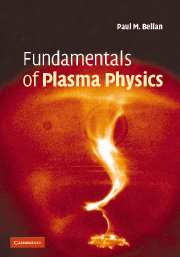Book contents
- Frontmatter
- Contents
- Preface
- 1 Basic concepts
- 2 The Vlasov, two-fluid, and MHD models of plasma dynamics
- 3 Motion of a single plasma particle
- 4 Elementary plasma waves
- 5 Streaming instabilities and the Landau problem
- 6 Cold plasma waves in a magnetized plasma
- 7 Waves in inhomogeneous plasmas and wave-energy relations
- 8 Vlasov theory of warm electrostatic waves in a magnetized plasma
- 9 MHD equilibria
- 10 Stability of static MHD equilibria
- 11 Magnetic helicity interpreted and Woltjer–Taylor relaxation
- 12 Magnetic reconnection
- 13 Fokker–Planck theory of collisions
- 14 Wave–particle nonlinearities
- 15 Wave–wave nonlinearities
- 16 Non-neutral plasmas
- 17 Dusty plasmas
- Appendices
- Bibliography and suggested reading
- References
- Index
10 - Stability of static MHD equilibria
Published online by Cambridge University Press: 05 June 2012
- Frontmatter
- Contents
- Preface
- 1 Basic concepts
- 2 The Vlasov, two-fluid, and MHD models of plasma dynamics
- 3 Motion of a single plasma particle
- 4 Elementary plasma waves
- 5 Streaming instabilities and the Landau problem
- 6 Cold plasma waves in a magnetized plasma
- 7 Waves in inhomogeneous plasmas and wave-energy relations
- 8 Vlasov theory of warm electrostatic waves in a magnetized plasma
- 9 MHD equilibria
- 10 Stability of static MHD equilibria
- 11 Magnetic helicity interpreted and Woltjer–Taylor relaxation
- 12 Magnetic reconnection
- 13 Fokker–Planck theory of collisions
- 14 Wave–particle nonlinearities
- 15 Wave–wave nonlinearities
- 16 Non-neutral plasmas
- 17 Dusty plasmas
- Appendices
- Bibliography and suggested reading
- References
- Index
Summary
Introduction
Solutions to Eq. (9.50), the Grad–Shafranov equation, (or to some more complicated counterpart in the case of non-axisymmetric geometry) provide a static MHD equilibrium. The question now arises whether the equilibrium is stable. This issue was forced upon early magnetic fusion researchers who found that plasma that was expected to be well confined in a static MHD equilibrium configuration would instead became violently unstable and crash destructively into the wall in a few microseconds.
The difference between stable and unstable equilibria is shown schematically in Fig. 10.1. Here a ball, representing the plasma, is located at either the bottom of a valley or the top of a hill. If the ball is at the bottom of a valley, i.e., a minimum in the potential energy, then a slight lateral displacement results in a restoring force, which pushes the ball back. The ball then overshoots and oscillates about the minimum with a constant amplitude because energy is conserved. On the other hand, if the ball is initially located at the top of a hill, then a slight lateral displacement results in a force that pushes the ball further to the side so that there is an increase in the velocity. The perturbed force is not restoring, but rather the opposite. The velocity is always in the direction of the original displacement; i.e., there is no oscillation in velocity.
- Type
- Chapter
- Information
- Fundamentals of Plasma Physics , pp. 342 - 384Publisher: Cambridge University PressPrint publication year: 2006



